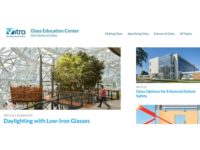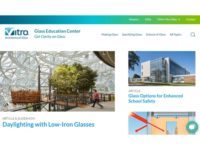Nestled within a dense forest of softwoods, the University of Southern Mississippi Gulf Coast Research Laboratory’s Marine Education Center honors its setting by featuring locally sourced southern yellow pine in the six-building campus’s structural timber system.
Tasked with designing a resilient classroom and research lab in the Gulf Coast town of Ocean Springs, Lake/Flato Architects specified generous expanses of Solarban 70 glass by Vitro Architectural Glass to help the built environment blend into the surrounding landscape while protecting against hurricanes and other potentially treacherous weather events.
“The design is focused on creating an indoor-outdoor relationship. So, with the incorporation of large windows, it was critical that our glazing spec perform well in order to achieve an energy-efficient building,” stated Grace Boudewyns, AIA, LEED AP BD+C, Lake Flato Architects, San Antonio. “By using Solarban 70 clear glass, we were able to meet our sustainability goals for the project by creating a tight building envelope. The glazing—and more specifically the color of the glazing—was fitting for a project like this, which is situated in the landscape.”
With its low solar heat gain coefficient (SHGC) of 0.27 and relatively high visible light transmittance (VLT) of 64% in a 1-inch insulating glass unit, Solarban 70 glass was an ideal choice. In addition to showcasing the center’s rustic exposed timber construction, the glass provides direct outdoor views from 95% of the floorplate and helps drive down the facility’s lighting power density to 0.94 watt-per-square-foot (w/sf). Combining these and other green building strategies, the center is predicted to consume 47% less energy than the national average for this educational building type.
The campus, which was named one of the top ten green projects of 2020 by the American Institute of Architects’ (AIA) Committee on the Environment (COTE), features outdoor and indoor classrooms, laboratories, administration offices, assembly spaces, exhibition areas and a pedestrian suspension bridge. While integrated throughout the campus, one particularly striking application of Solarban 70 glass is the house-shaped, wall-to-ceiling glazing comprising the entire elevation of one of the classrooms.
For more information about Solarban 70 glass, and the rest of Vitro Glass’s full line of architectural glasses, visit www.vitroglazings.com






